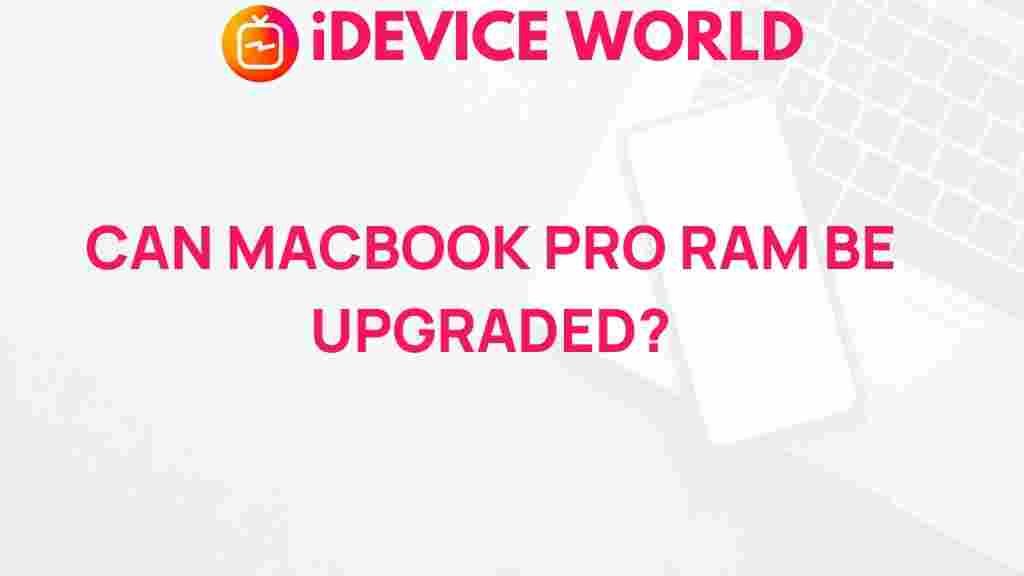Unveiling the Mystery: Upgrading RAM in MacBook Pro
The MacBook Pro is a powerful laptop that has become a favorite among professionals and creatives alike. Its robust performance and sleek design make it an ideal choice for various tasks, from graphic design to software development. However, as applications become more demanding and multitasking becomes a necessity, many users find themselves wondering if upgrading the RAM in their MacBook Pro could enhance their device’s performance. In this comprehensive guide, we will explore the benefits of upgrading RAM, the step-by-step process for different MacBook Pro models, troubleshooting tips, and a conclusion to help you make an informed decision.
Why Upgrade RAM in Your MacBook Pro?
Upgrading the RAM in your MacBook Pro can significantly improve its performance. Here are a few reasons why you might consider an upgrade:
- Enhanced Multitasking: More RAM allows your MacBook Pro to handle multiple applications simultaneously without slowing down.
- Improved Performance: A RAM upgrade can lead to faster application load times and improved responsiveness.
- Better Handling of Large Files: If you work with large files, such as video or graphic editing, additional RAM can help manage these tasks more efficiently.
- Future-Proofing: Upgrading RAM can extend the lifespan of your MacBook Pro by keeping it relevant for future software requirements.
Understanding RAM Compatibility with MacBook Pro
Before diving into the upgrade process, it’s essential to understand the compatibility of RAM with your specific MacBook Pro model. Apple has produced several iterations of the MacBook Pro, and the upgrade process can vary significantly. Here are some factors to consider:
- Model Year: The year your MacBook Pro was manufactured affects the type of RAM it uses.
- RAM Type: Different models require different RAM types (e.g., DDR3, DDR4, etc.).
- Maximum RAM Capacity: Each MacBook Pro has a maximum RAM limit. Ensure your upgrade stays within this limit.
For detailed specifications on your model, visit the Apple Support page.
Step-by-Step Process to Upgrade RAM in MacBook Pro
Upgrading RAM in your MacBook Pro can be a rewarding DIY project. Below, we outline the process for various models, ensuring you have a clear guide to follow.
Tools Required
Before you begin, gather the following tools:
- Small Phillips screwdriver
- Plastic spudger or opening tool
- Anti-static wrist strap (optional, but recommended)
- New RAM modules
1. Determine Your MacBook Pro Model
To find out which MacBook Pro model you have, click on the Apple logo in the upper-left corner of your screen, then select About This Mac. This will show you the model year and specifications.
2. Prepare Your Workspace
Ensure you’re working in a clean, static-free environment. Disconnect your MacBook Pro from the power source and any peripheral devices.
3. Open Your MacBook Pro
For most MacBook Pro models, follow these steps:
- Use the Phillips screwdriver to remove the screws on the back cover. Keep track of the screws as they can be different sizes.
- Carefully lift the back cover off using the plastic spudger to avoid damaging any clips.
4. Locate the RAM Slots
Once the back cover is removed, locate the RAM slots. In most models, the RAM is easily accessible, but in some newer versions, it may be soldered to the motherboard, making upgrades impossible.
5. Remove Old RAM (if applicable)
If your model allows for RAM upgrades, gently push the clips on either side of the RAM module to release it. Carefully slide the module out of the slot.
6. Insert New RAM Modules
Align the notches on the new RAM module with the slot and firmly press it in until the clips click into place. Ensure that the module is seated correctly and secure.
7. Reassemble Your MacBook Pro
Once the new RAM is installed:
- Replace the back cover and reattach the screws.
- Reconnect any peripheral devices and the power source.
8. Verify the Upgrade
After turning on your MacBook Pro, click on the Apple logo and select About This Mac. Check the Memory section to confirm that the new RAM is recognized.
Troubleshooting Common Issues
If your MacBook Pro fails to recognize the new RAM or experiences performance issues, consider the following troubleshooting tips:
1. Check RAM Compatibility
Ensure that the RAM you purchased is compatible with your specific MacBook Pro model. Refer back to the specifications you gathered earlier.
2. Reseat the RAM Modules
Sometimes, RAM may not be properly seated. Power off your MacBook Pro, open it up, and reseat the RAM modules to ensure they are securely in place.
3. Run Apple Diagnostics
To check for hardware issues, restart your MacBook Pro and hold down the D key while it boots up. This will run Apple Diagnostics, which can help identify memory issues.
4. Reset the NVRAM
If you’re still encountering problems, resetting the NVRAM can sometimes resolve issues related to memory. To do this:
- Shut down your MacBook Pro.
- Turn it on and immediately hold down Option + Command + P + R for about 20 seconds.
Conclusion
Upgrading the RAM in your MacBook Pro can be a straightforward process that yields significant performance improvements. By following the steps outlined in this guide, you can enhance your device’s capabilities and ensure it remains efficient for your workload. Always remember to check compatibility and take necessary precautions to avoid damaging your device.
If you decide to upgrade your RAM, share your experience and tips with fellow MacBook Pro users. For more detailed information on maintaining your MacBook Pro, check our other articles here.
Embrace the power of your MacBook Pro and enjoy a smoother computing experience!
This article is in the category Guides & Tutorials and created by iDeciveWorld Team

1 thought on “Unveiling the Mystery: Upgrading RAM in MacBook Pro”